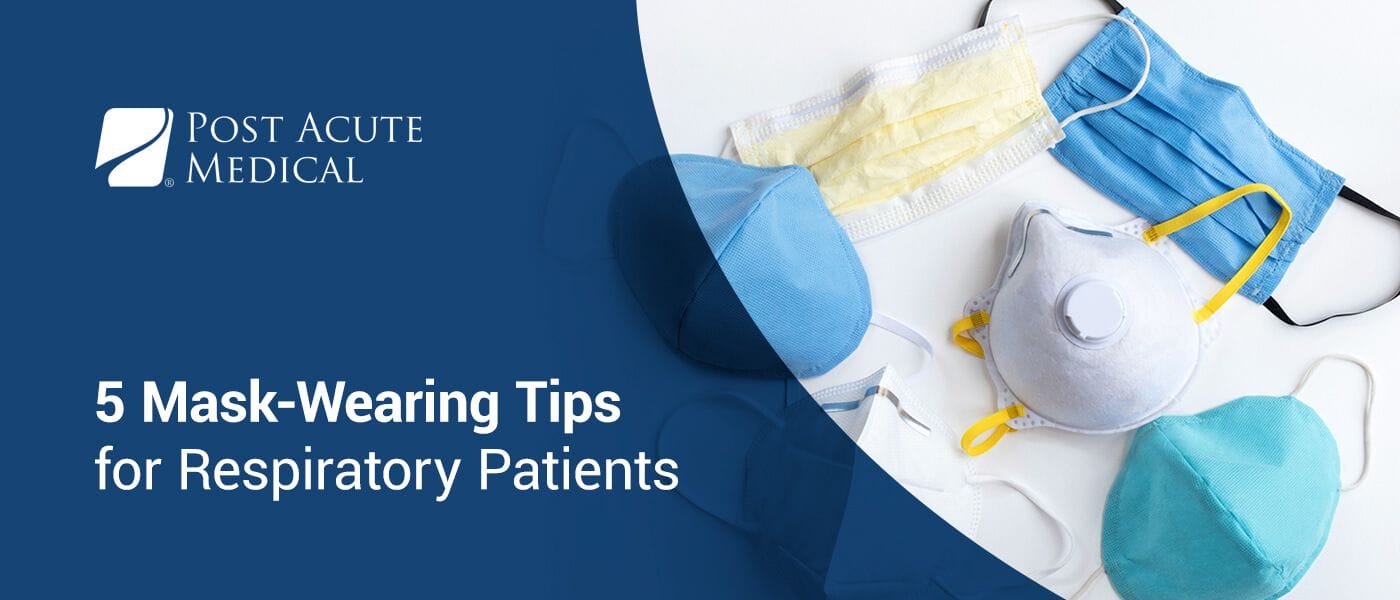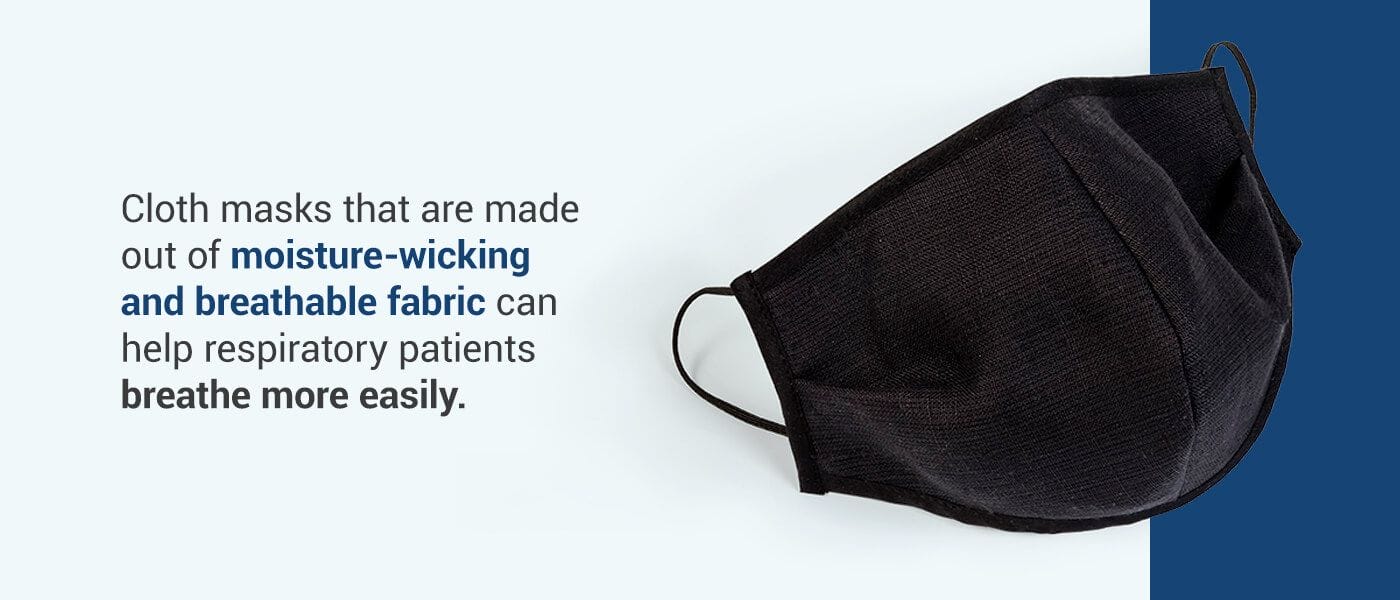
While wearing a mask in public can help prevent the spread of germs, masks may be difficult for some respiratory patients to wear and breathe in comfortably. Respiratory problems such as asthma, chronic obstructive pulmonary disease (COPD) or emphysema can cause some people to experience difficulty breathing in a mask. Learning how to wear a face mask comfortably can help respiratory patients stay safe and improve their ability to breathe when wearing a face covering.
Explore Cardiopulmonary Rehabilitation Offered by PAM Health
How Should a Face Mask Fit?
A face mask should be snug yet comfortable to reduce the possibility of transmitting COVID-19 and other germs. Face masks should not feature exhalation valves, as these can cause virus particles to escape from the mask.
When considering different face mask fits, it is vital to ensure your face mask is the right size, fits appropriately and prevents the transmission of virus particles. There are numerous styles of face masks, but the most important aspect to consider is functionality. The Centers for Disease Control and Prevention (CDC) recommends the following attributes in a mask:
- Multiple layers: It is recommended that a face mask has at least two layers. Face masks with more layers can provide additional protection against the transmission of germs, which research has confirmed in two-layer and three-layer masks.
- Snug fit: A properly sized face mask should fit closely against the sides of your face and not have any gaps in coverage. This fit helps to prevent inhaling or exhaling potential virus particles.
- Nose wire: A nose wire is a necessary component of a proper face mask that can prevent air from passing through the top of your mask.
- Appropriate fabric: Face masks should be made of a comfortable, breathable fabric. Certain materials, such as vinyl, can make it more difficult to breathe comfortably. With any face mask, you will want to choose an easily washable option.
5 Mask-Wearing Tips for Respiratory Patients
Wearing a face mask is an effective way to avoid exposure to germs, reduce the transmission rates of COVID-19 and maintain a healthy lifestyle. A mask that is easy to breathe in allows you to confidently and more easily complete necessary tasks. These five mask-wearing tips for respiratory patients can improve your experience wearing a face mask:
1. Avoid Hot or Humid Weather
Many people find it more difficult to breathe properly through a mask in hot or humid weather. If you need to go out, it is best to plan your trip on a cooler day and avoid high temperatures. Additionally, you can take a trip earlier in the morning or later in the afternoon when the heat is not as strong. Both indoor and outdoor humidity can affect respiratory conditions, including COPD. Humid air can activate nerves in your lungs that may narrow your airways, and it can also cause the air to become stagnant and trap potential allergens.
2. Practice at Home
When people first begin wearing a mask, it may take time to acclimate to this new sensation. Respiratory patients may experience more difficulty breathing in a mask and require additional time to adjust to wearing a mask. It can be beneficial to practice wearing a mask at home, allowing you to experience the sensation in a comfortable environment where you can easily remove the mask if needed.

3. Pick a Comfortable Mask
One of the best mask-wearing tips is to choose a comfortable face mask that fits your facial features. Cloth masks that are made out of moisture-wicking and breathable fabric can help respiratory patients breathe more easily. Whichever style or material mask you choose, it is essential to remember that it must cover your mouth and nose adequately.
4. Make High-Risk Trips Quick
When you need to make a trip out of the house, it is best to make these trips as quick as possible. Limiting your time in a busy area can be safer and lessen the amount of time you will need to wear a face mask. Creating a shopping list or planning your outing can help you make high-risk trips more efficient and quick. After a trip, it is recommended to clean your face mask to prevent the spread of germs and COVID-19. Additionally, you can make small adjustments to your face mask to improve its effectiveness and protection.
5. Exercise Indoors
Exercising outdoors is a popular option for many people, but it may mean you need to wear a face mask. Consider exercising indoors at home to avoid having to wear a face mask while working out. Respiratory patients may experience increased difficulty trying to breathe through a mask when they sweat. Additionally, the warmth of the outdoors will contribute to your overall body temperature and may make it harder to breathe comfortably.
Taking off Your Mask
When taking off your face mask, it is important to remember to avoid touching the mask’s fabric. Touching the main portion of the face mask could transfer germs from the surface and increase the chance of breathing in these particles. To safely take off your face mask, only touch the ear loops or ties.
After you have removed the mask, you can fold the face mask in two by bringing the outside corners together. Immediately after taking off your mask, you should avoid touching surfaces or your eyes, ears or mouth. It is recommended to apply hand sanitizer or thoroughly wash your hands after removing your mask.
Cleaning Your Mask
Research has shown that 79% of people are not washing their face masks. Generally, it is recommended to wash your face mask after each day of use. You can wash your face mask in your washing machine or by hand in a sink.
Washing Your Face Mask
You can toss your face mask in when you do your normal laundry and use regular laundry detergent. It is best to follow the appropriate settings on your washer machine according to the type of fabric your face mask is made out of. If you are unable to clean your face mask regularly or need to make daily trips out of the house, you may want to consider having multiple face masks so you can always choose a clean one to wear.
Drying Your Face Mask
After washing your mask, you will need to dry it. You can use a standard warm or hot dryer, making sure to follow appropriate settings depending on the fabric choice. You can also let your face mask hang in direct sunlight to air dry. If there is no direct sunlight, you can place your face mask inside and have it lay flat to dry.

Trust Post Acute Medial for High-Quality Patient Care
If you or someone you love is experiencing respiratory failure, Post Acute Medical can help. We focus on putting patients first and offering state-of-the-art care for rehabilitation. Our team of experts provides comprehensive treatments that are fully customizable for each patient. We offer physical therapy, speech therapy, occupational therapy and specialty physicians and nurses.
We believe helping each patient return to their highest possible functional status is most important. We maintain an environment that supports meaningful improvement and recovery from various injuries, disabilities and illnesses.
Find a Post Acute Medical location near you to learn more about our services today.


